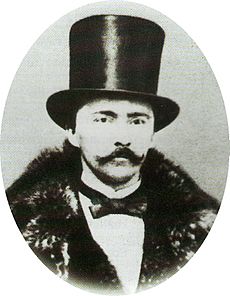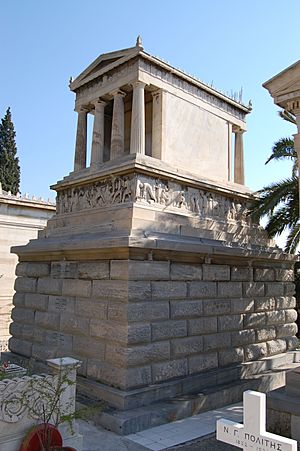Heinrich Schliemann facts for kids
Quick facts for kids
Heinrich Schliemann
|
|
|---|---|
| Born | 6 January 1822 Neubukow, Mecklenburg-Schwerin, German Confederation
|
| Died | 26 December 1890 (aged 68) |
| Nationality | German |
| Spouse(s) |
Ekaterina Petrovna Lyschin
(m. 1852; div. 1869)Sophia Schliemann
(m. 1869) |
| Children | 5 (3 w/ Lyschin, 2 w/ Schliemann, incl. Agamemnon) |
| Scientific career | |
| Fields | Archaeology |
| Influenced | Arthur Evans V. Gordon Childe |
Johann Ludwig Heinrich Julius Schliemann (6 January 1822 – 26 December 1890) was a German businessman. He became a pioneer in the field of archaeology. He believed that the places mentioned in the ancient Greek stories by Homer were real. Schliemann excavated sites like Hisarlik, which is now thought to be the city of Troy. He also dug at Mycenae and Tiryns, which were important Mycenaean cities. His work helped show that Homer's famous poem, the Iliad, might be based on real historical events. However, Schliemann's digging methods were sometimes criticized for damaging important historical artifacts.
Contents
Early Life and His Dream
Schliemann was born on January 6, 1822, in Neubukow, Germany. He was one of nine children. His father was a pastor who loved to tell him stories from Homer's Iliad and Odyssey. He also gave Heinrich an illustrated history book. Schliemann later said that at age seven, he declared he would one day find and dig up the city of Troy.
His family was not wealthy. Heinrich had to leave school early when he was 14. He became an apprentice at a grocery store. He worked there for five years. After an injury, he moved to Hamburg and then became a cabin boy on a ship. The ship sank, but he survived and ended up in the Netherlands. There, he found work as a messenger and later as a bookkeeper in Amsterdam.
A Businessman Becomes an Archaeologist
In 1844, when he was 22, Schliemann started working for an import/export company. He was sent to St. Petersburg, Russia, in 1846. He was very good at learning languages. He claimed he could learn a new language in just six weeks. By the end of his life, he could speak many languages, including English, French, Russian, Greek, and Latin. This skill helped him greatly in his business career.
Schliemann became very wealthy through his business dealings. He made money in various trades. For example, he bought and sold gold during the California gold rush. He also made a fortune during the Crimean War by supplying goods to the Russian government. By 1858, at 36 years old, Schliemann was rich enough to stop working. He decided to follow his childhood dream: finding the ancient city of Troy.
Searching for Ancient Cities
Heinrich Schliemann was not a trained archaeologist. He was an amateur, but he was very passionate about Homer's stories. He wanted to find the actual remains of the cities from these epic tales. Many people call him the "father of pre-Hellenistic archaeology."
In 1868, Schliemann visited sites in Greece. He wrote a book where he suggested that a place called Hissarlik was the real site of Troy. He even earned a PhD from a German university for his ideas.
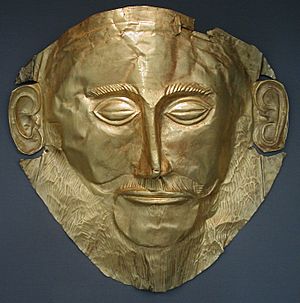
Discovering Troy
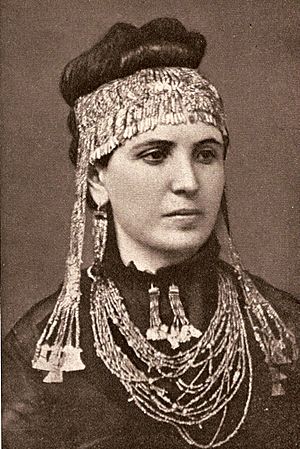
Schliemann's main goal was to find Troy. Before him, another amateur archaeologist, Frank Calvert, had suggested that Hissarlik was the correct location. In 1870, Schliemann began digging at Hissarlik. By 1873, he had uncovered nine layers of ancient cities buried on top of each other.
One day in 1873, Schliemann found a collection of gold and other metal objects. He believed this was the famous "Priam's Treasure" from the Trojan War. He quickly removed the treasure himself. Later, his wife, Sophia, was photographed wearing some of the gold jewelry.
However, modern research shows that the layer Schliemann thought was Homer's Troy was actually much older. It was from about 3,000–2,000 BCE, which is too early for the Trojan War described by Homer. The real Troy from Homer's time was likely a different layer.
Schliemann secretly took the treasure out of Turkey. The Turkish government sued him, and he had to pay a fine. Eventually, some of the artifacts ended up in the Pushkin Museum in Moscow.
Excavating Mycenae
In 1876, Schliemann started digging at Mycenae in Greece. There, he made another amazing discovery: the Shaft Graves. These graves contained skeletons and more beautiful gold objects, including the famous "Mask of Agamemnon." These findings were very important for understanding the ancient Mycenaean civilization.
Schliemann continued his archaeological work. He returned to Troy for more excavations and also dug at Tiryns with another archaeologist, Wilhelm Dörpfeld.
Personal Life
Schliemann married Ekaterina Petrovna Lyschin in 1852. They had three children together. Because of his many travels for business and archaeology, he was often away from his family.
Later, Schliemann divorced Ekaterina. In 1869, he married Sophia Engastromenos, who was 17 years old. Sophia was from Athens and shared his love for ancient Greece. They had two children, Andromache and Agamemnon Schliemann.
Death
In 1890, Schliemann had an ear infection that needed surgery. He left the hospital too soon and traveled to several cities. His ear condition got worse. He collapsed in Naples, Italy, on Christmas Day 1890 and died the next day.
His body was taken to the First Cemetery of Athens in Greece. He was buried in a grand tomb shaped like an ancient Greek temple. The carvings on the tomb show him digging at Mycenae and other sites.
Legacy and Impact
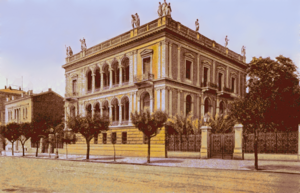
Schliemann's beautiful home in Athens, called the Iliou Melathron (meaning "Palace of Ilium"), is now the Numismatic Museum of Athens.
Schliemann, along with Arthur Evans, was a very important figure in studying the Aegean civilization during the Bronze Age. Schliemann had planned to dig at Knossos but died before he could. Arthur Evans later bought that site and continued the work.
While Schliemann's discoveries were amazing, his digging methods were sometimes criticized. He dug very quickly and sometimes damaged important layers of history. Later archaeologists used more careful methods. However, many agree that Schliemann helped start the scientific study of archaeology. He showed that ancient myths could lead to real historical discoveries.
Schliemann also supported the removal of medieval buildings from the Acropolis of Athens. This was a controversial decision at the time.
See also
 In Spanish: Heinrich Schliemann para niños
In Spanish: Heinrich Schliemann para niños
- List of archaeologists
- List of polyglots


